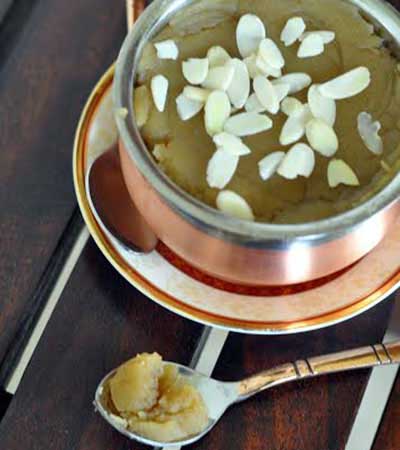Why Kada Prasad is the Best Thing About Langar
- By Monika ManchandaLoading...
- | 30 July 2015 3:00 PM IST
 X
X
 Kada Prasad is typically served at Gurudwaras. Photo: Monika Manchanda
Kada Prasad is typically served at Gurudwaras. Photo: Monika Manchanda
I am not really a religious person; in fact I am an agnostic fast moving towards the atheist route considering the way religion is moving forward is anything but peaceful. But then that is a story for another post, another day. So in spite of not being religious, there is something about a Gurudwara (worship place of Sikhs in Punjab) that attracts me. The peace, the calm and most definitely the food, it keeps drawing me back to them time and again. Langar as they call it, all Gurudwaras serve free meals as prasad, which are essentially made as a community effort called seva (to serve others).
If you walk into the kitchen area of a Gurudwara, you can find many men and women rolling rotis, making dal, chopping vegetables, cleaning vessels, serving people with love. While growing up I used to wonder what do people get by doing seva, and then when I was a teenager, one fine day I covered my head with a stole over my jeans and t-shirt and entered the sanctorum of food, a place of equalisation where everyone leaves their class, status and riches and comes as equals to serve God through an act of feeding people. The aromas and energy around you give you a lease of life, a spring in your step that I could feel even as a teenager.
That particular seva day I got lucky since the person who used to help the expert biji (grandmom) make the kada prasad wasn’t present, and I was assigned as an assistant to biji. Anyone who has ever entered a Gurudwara can probably never forget the taste of the ghee-rich kada prasad, which is essentially atta (whole wheat flour) halwa loaded with ghee and the main prasad of any Gurudwara.
I think I was 3 or 4 when I first got the taste of it, and it’s weird that I still remember how delighted I was with it, I went back for a second helping and then the third after which the gyaniji gently told me that I have had enough. Equally weird is the fact that I don’t remember anything of how I made the prasad that seva day apart from the fact that I woke up with paining arms the next morning.
Many years later, I asked my own grandmother to teach to make the kadaprasad, and was handed over the recipe, which has been passed through generations to my badi mummy. With tons of ghee and love, I tried recreating it at home and I have to say that in spite of the fact that it was a finger-licking yummy halwa, the one that you eat in the Gurudwara does have something to that I couldn’t replicate at home, may be it’s the energy. But whatever said, you can take my word on it that this will probably be the best kada prasad you will ever make at home
Recipe for Kada Prasad (serves 5-6)
Time taken: 45 minutes
Ingredients
1 cup whole wheat flour
1 cup sugar
3.5 cups water
1 cup ghee
1 tbsp besan
¼ cup almond flakes
Method
1. In a heavy bottom kadai, heat ghee till it is hot but not smoking. Add the wheat to it and roast it the flour turns golden brown. This step is the most critical step in the making of kada prasad, both in terms of the quality of whole wheat and the way you do it.
Note: For a better halwa, you need coarse ground atta, a finely-ground packaged atta will not give you the texture you are looking for. My granny used to say that if you don’t have coarse ground atta, you might as well not make the kada prasad.
While roasting the atta, the most critical thing is the heat, you will have to alternate between low and medium low heat for an even roast of the wheat and once that is done you are safe. My granny used to say that adding a tbsp of besan helps in roasting the atta better and I consistently follow the tip. You know the atta is well roasted when it is golden brown and smells slightly nutty.
2. While the atta is roasting, heat sugar and water together till it the sugar is melted and keep it warm on the low flame.
3. Add the water to the roasted atta and keep stirring vigorously so that there are no lumps formed. Cook on low flame, stirring continuously till the ghee leaves the sides and the mixture is thickened to a halwa consistency.
4. Garnish with almond flakes and serve hot.
Monika's food blog Sin-A-Mon Tales comprises reviews, recipes and food stories from her travels and childhood. She also writes for many websites and publications. An avid reader and an obsessive traveller, Monika is always looking for food history and culture.



